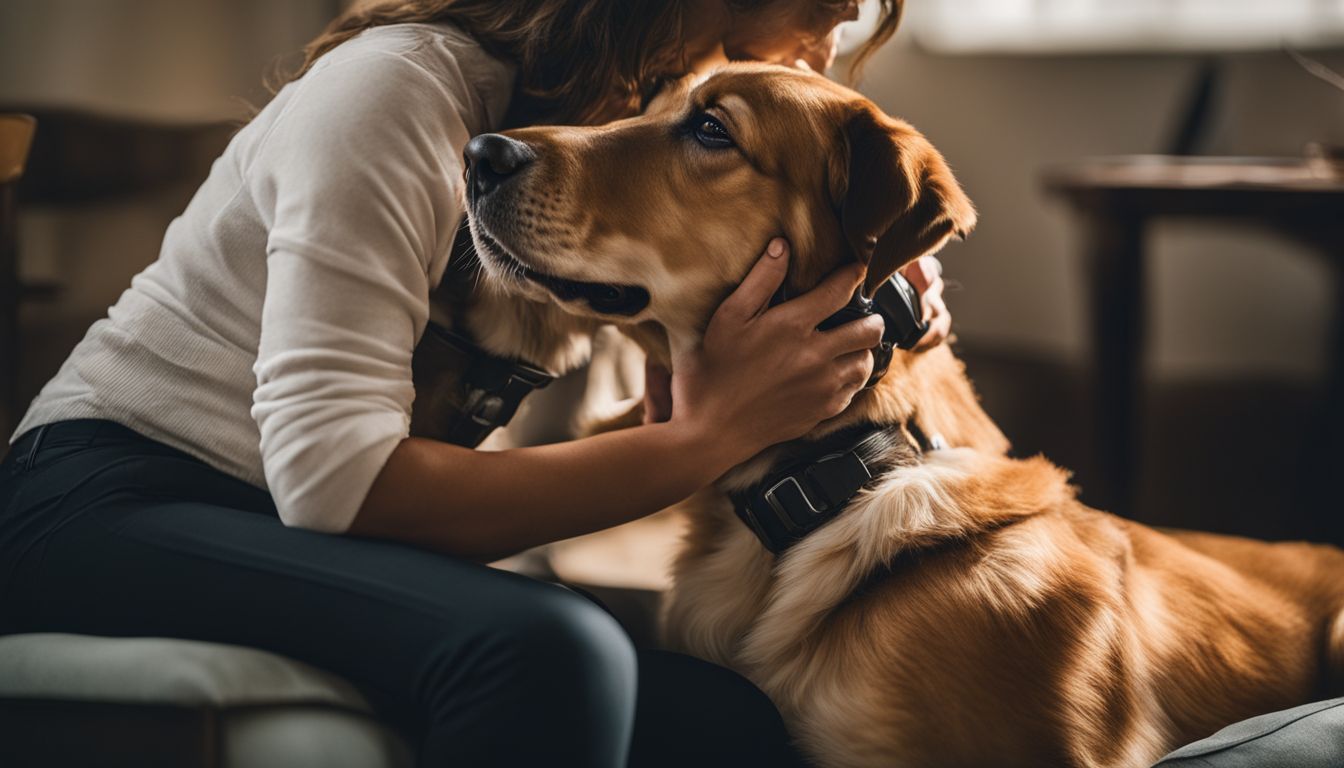Service Dogs For Seizure Disorders: Vital Assistance And Support
Living with seizure disorders can be tough. A service dog for seizure disorders offers real help. Our article shows how these canine helpers can change lives by providing assistance and support.
Keep reading to discover more.
What are Seizure Dogs?

Seizure dogs are trained to sense seizures and provide vital assistance to individuals with seizure disorders. Their main purpose is to alert, assist, and get help for their owners during and after a seizure.
Definition and purpose
Seizure dogs are trained to help people with seizure disorders. These dogs do more than just provide companionship. They have special training to assist during seizures. This means they can sense when a seizure might happen and alert their owner or others.
Some know how to get help when their owner has a seizure. Canine Partners for Life is one group that trains these service animals.
These dogs support people in many ways, making life safer and giving them more freedom. For someone with epilepsy, having a seizure dog means they can do more things on their own without fear.
Service dogs for seizures are also there for emotional support, helping owners feel less alone with their condition. They turn lights on and off, open doors, and even help carry things for people who need it due to physical disabilities related to seizures like PoTS and Addison’s disease.
How Can Seizure Dogs Help?

Seizure dogs can alert before seizures and assist during episodes, providing vital support. To discover more about their incredible assistance, continue reading!
Alerting before seizures
Dogs trained to sense seizures can tell when a seizure might happen. They do this by noticing changes in how a person smells or acts. These clever pets may bark or act differently to warn their owner.
This gives the person time to get safe before the seizure starts.
After sending an alert, these dogs can also help during the seizure. They move on to tasks like getting help from others or providing comfort. This makes them not just pets but lifelines for people with epilepsy and other seizure disorders.
Assisting during seizures
After a seizure dog alerts its person of an incoming seizure, it then acts to assist during the event. These amazing animals stay close by their owner’s side to offer physical support and comfort.
If someone has a fall, the dog can also act as a brace to help them get back up or find a safer position. For individuals experiencing less intense seizures like petit-mal seizures, the dog might simply provide companionship through the episode, calming their person with steady presence.
Seizure dogs are trained to perform specific tasks specifically for moments during and immediately after seizures. They might lie down next to their owner to prevent injury or use their body weight in a protective way if needed.
In some cases where movement is restricted due to convulsions or muscle stiffness, these dogs can fetch medication or press emergency buttons installed at home that call for medical aid.
This level of assistance from seizure service dogs ensures safety and brings peace of mind not just for those with epilepsy but also their families and carers.
Getting help during and after seizures
Seizure dogs play a crucial role by fetching help during and after seizures. They are trained to press emergency buttons or bark to alert others nearby. This ensures quick assistance for their owners, reducing the risk of injury.
These skilled companions can even stay close, offering comfort until help arrives or the seizure passes.
They also have an amazing ability to detect changes in odour or behaviour before a seizure happens. This means they can alert someone that their owner needs help soon, providing precious time to get to a safe place or call for support.
With these dogs around, individuals with epilepsy gain more safety and peace of mind in their daily lives.
How to Obtain a Seizure Dog
Obtaining a Seizure Dog involves applying, qualifying, and matching with a custom-trained dog. The process includes an application, qualification, and personalised training for client-dog matching.
Application process
To get a seizure service dog, you first fill out an application with an organisation that trains them. You’ll need to share information about your seizures, like how often they happen and what they’re like.
This helps the trainers understand your needs. Sometimes, you might also have to show medical records or get a letter from your doctor.
After sending in your application, there’s usually a waiting period. This is because training a seizure alert dog takes time and each one is trained for their future owner’s specific needs.
In this stage, organisations match dogs with people based on things like personality and how well they work together. Some places let you visit the dogs during training to start building a bond early on.
Qualification information
To get a seizure service dog, you must meet certain qualifications. People with epilepsy or those who have seizures can apply. Health professionals use tests like the electroencephalogram to understand your seizures better.
This helps to decide if a service dog can really help you.
Some programmes also look at your living situation and how well you can care for a dog. They want to make sure the dog will have a good home. If you qualify, they match you with the right trained seizure alert dog.
These dogs are often breeds like German Shepherds because of their smartness and good behaviour.
Client-dog matching
Matching a client with the right seizure service dog is a key step. Each person has different needs based on their condition, such as epilepsy or non-epileptic seizures. The matching process looks at these needs closely.
For example, someone who gets headaches or senses auras before a seizure might need a dog that can alert them quickly.
Trainers also consider the client’s lifestyle and environment. A person who lives alone might need a dog trained to get help from others during or after seizures. This special training ensures that the dog’s skills fit perfectly with what the person requires for safety and independence.
Matching takes time but leads to strong partnerships between clients and their new canine helpers, offering support and boosting self-confidence.
Custom-training process
The custom-training process for seizure dogs involves tailoring the training to each individual’s specific needs. This includes teaching the dog how to recognise the subtle signals of an oncoming seizure and respond accordingly, as well as providing support during and after a seizure event.
The meticulous matching of clients with suitable dogs ensures a strong bond between the two, laying the foundation for effective teamwork.
This specialised training equips both the dog and its owner with essential skills, fostering independence and enhancing their quality of life. By carefully integrating key concepts into their training, such as alerting before seizures and seeking help when needed, these service dogs play a crucial role in supporting individuals with seizure disorders.
The trainers’ expertise in utilising positive reinforcement methods further enhances success rates, highlighting the impactful nature of this bespoke process that empowers both humans and canines alike.
Next – The Impact of Seizure Dogs
The Impact of Seizure Dogs
Seizure dogs increase independence and boost self-esteem. To learn more, read the full blog.
Increased independence
Seizure service dogs provide vital support, increasing the independence of individuals with seizure disorders. These specially trained dogs offer companionship and assistance to help mitigate the physical and emotional challenges that come with seizures, fostering a greater sense of freedom and autonomy for their handlers.
This enhanced level of independence allows individuals to engage more confidently in daily activities, ultimately improving their overall quality of life.
By providing reliable alerting before seizures, assisting during episodes, and seeking help when necessary, these remarkable dogs empower individuals to navigate their lives with increased self-assurance.
In addition to practical assistance, they also contribute to boosting the self-esteem and mental well-being of those living with seizure disorders. This invaluable partnership between humans and seizure service dogs not only enhances independence but also promotes a more fulfilling and inclusive lifestyle for people affected by this condition.
Personal stories of success
Individuals who have received seizure service dogs have reported life-altering improvements in their daily lives. These success stories highlight the immense impact of these specially trained canines.
One such example is Sarah, who had been experiencing frequent seizures due to epilepsy. After being matched with a seizure service dog, she noticed a significant decrease in the frequency of her seizures and felt more empowered to lead an independent life.
Another remarkable account comes from James, whose seizure alert dog provided crucial assistance during an unexpected episode, ultimately saving his life. These compelling narratives underscore the invaluable support and enhanced safety that seizure service dogs bring to individuals living with seizure disorders.
Moreover, research has shown that 74% of individuals with epilepsy experienced fewer seizures after obtaining a trained seizure alert dog. Furthermore, testimonials from over 500 recipients of these service dogs revealed an overwhelming sense of security and increased confidence when navigating daily activities amid potential seizure risks.
With each heartening account shared by those benefitting from these loyal companions, it becomes evident that receiving a well-matched and thoroughly trained seizure alert dog can significantly improve the quality of life for individuals coping with epilepsy or other seizure disorders.
Get involved: donate or sponsor a dog
Support the training and placement of seizure service dogs by donating to reputable organisations such as Canine Partners for Life. Your contribution can change lives, providing vital assistance and companionship to individuals with seizure disorders.
Sponsoring a dog’s training can make a real difference in providing increased independence and support for those in need. Your donations directly impact the well-being of individuals and help create lasting partnerships between trained dogs and their owners.
Ready to learn about how these incredible dogs are custom-trained to assist individuals with seizure disorders? Let’s explore “The Impact of Seizure Dogs.
Conclusion
Seizure service dogs play a vital role in supporting individuals with seizure disorders. These faithful companions can alert, assist, and even get help during and after seizures. Obtaining a seizure dog involves an application process, qualification information, and custom training.
The impact of these amazing dogs includes increased independence and inspiring success stories from their owners. Considering the benefits they bring, supporting organisations that train these dogs is essential for ensuring more people can benefit from this vital assistance.
FAQs
1. What does a seizure service dog do?
A seizure service dog is trained to help people with seizure disorders. They can alert them before a seizure happens.
2. How much does a seizure service dog cost?
Getting a trained seizure alert dog can be pricey. The cost includes their training, pedigree, and the care they need.
3. Can any dog become a seizure alert dog?
Not all dogs can do this job. Dogs with the right demeanour and pedigree are carefully chosen and trained for this role.
4. How do these dogs help during an actual seizure?
During a seizure, these dogs provide physical support and comfort. They also protect their owner from harm until the episode passes.

